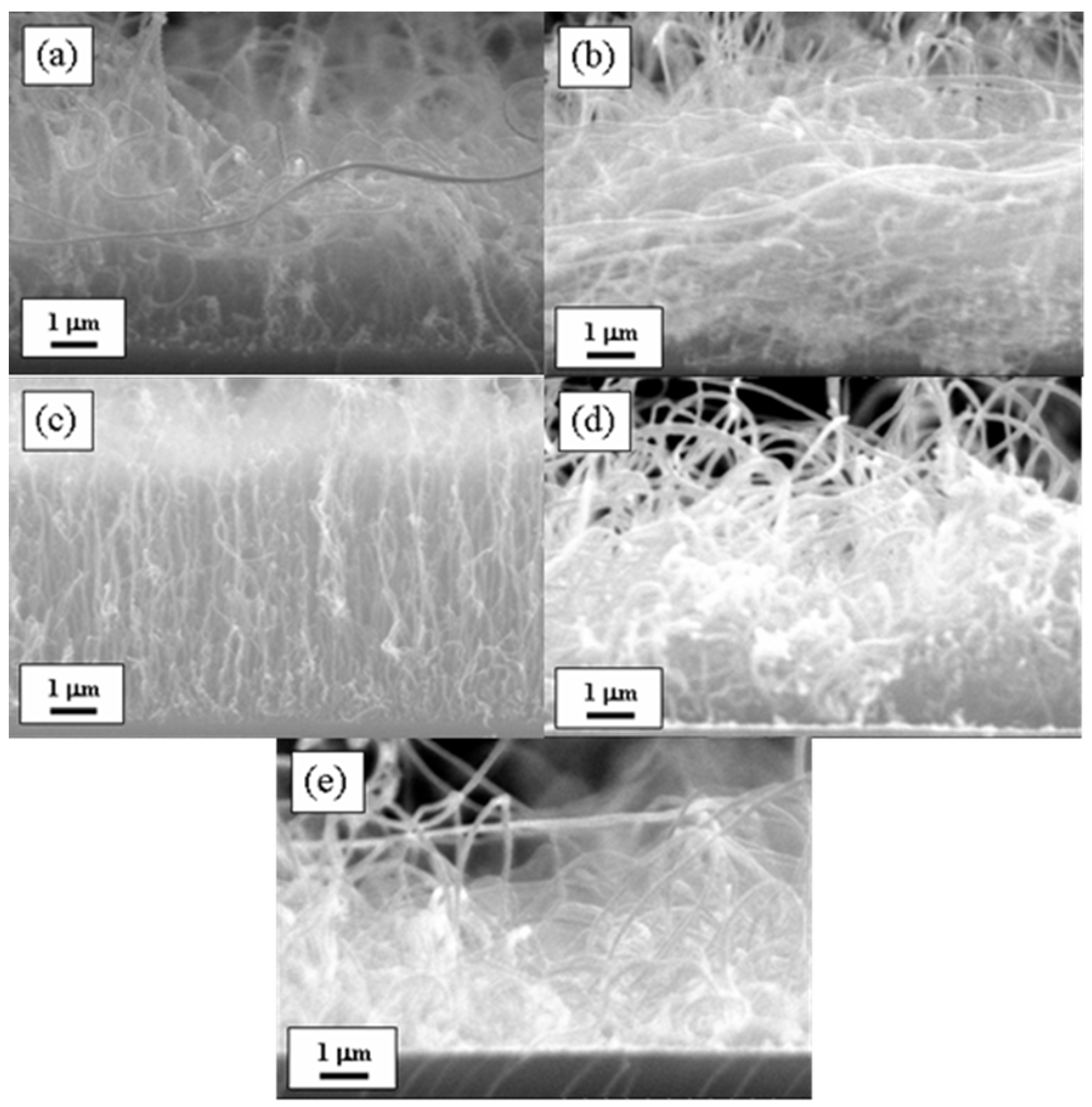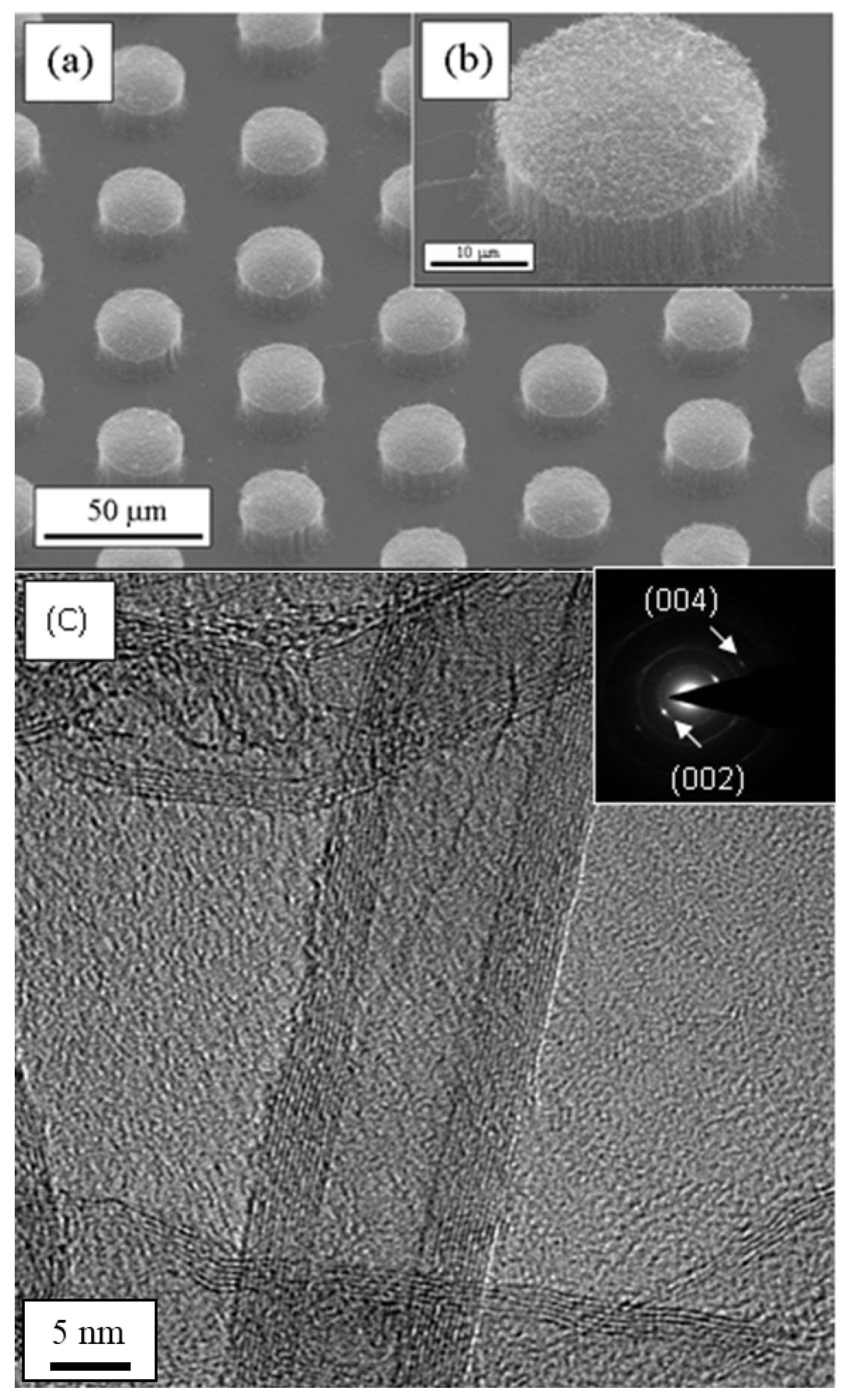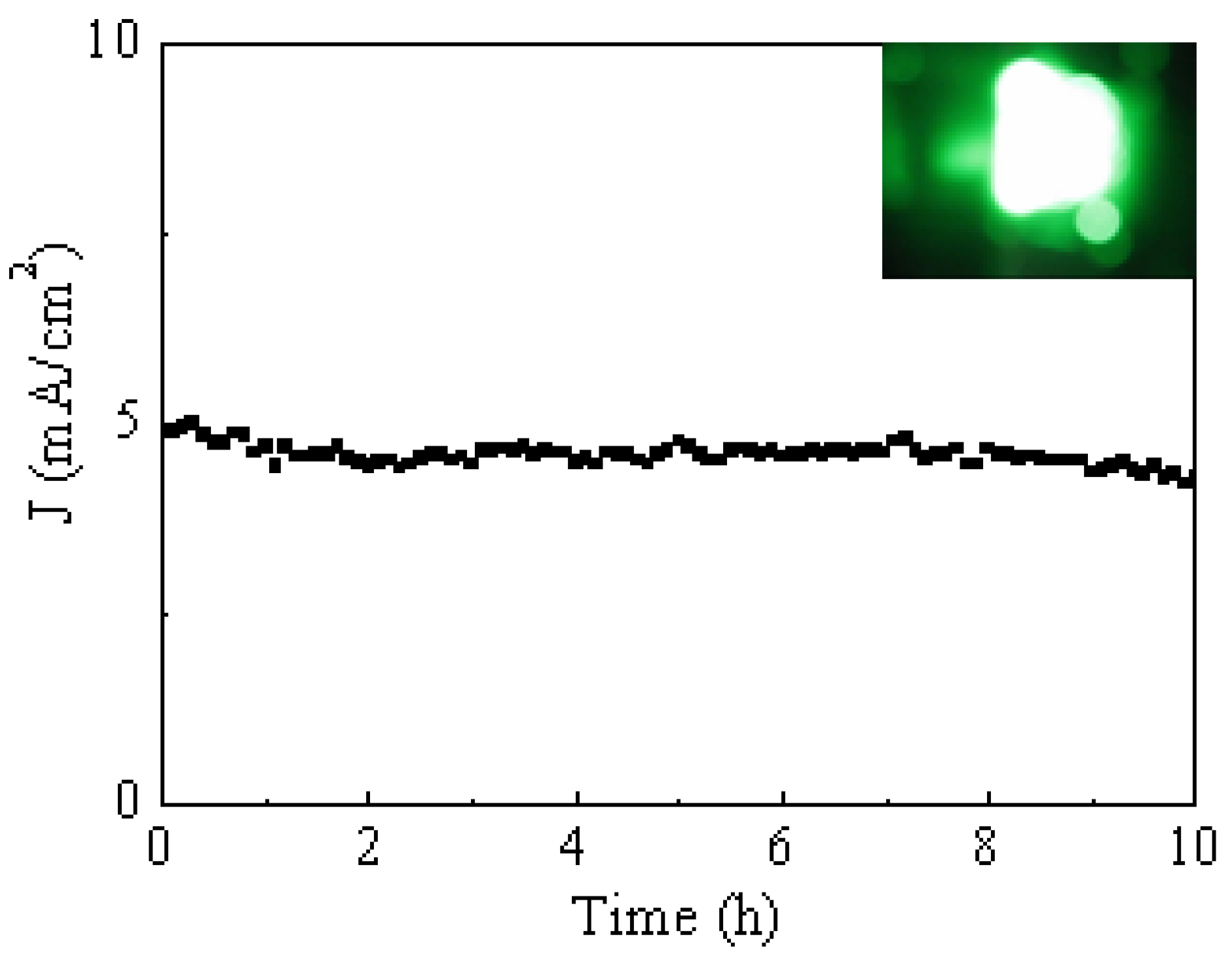Multi-Walled Carbon Nanotube Growth on Fe/Al-Coated Thermally Stable Glass Substrates with Relevance to Field Emission
Abstract
1. Introduction
2. Materials and Methods
3. Results and Discussion
4. Conclusions
Author Contributions
Funding
Data Availability Statement
Acknowledgments
Conflicts of Interest
Abbreviations
| CNTs | Carbon nanotubes |
| CVD | Chemical vapor deposition |
| SEM | Scanning electron microscopy |
| TEM | Transmission electron microscopy |
| SAED | Selected area electron diffraction |
| FN | Fowler–Nordheim |
References
- Iijima, S. Helical microtubules of graphitic carbon. Nature 1991, 354, 56–58. [Google Scholar] [CrossRef]
- Giannetto, M.J.; Johnson, E.P.; Watson, A.; Dimitrov, E.; Kurth, A.; Shi, W.; Fornasiero, F.; Meshot, E.R.; Plata, D.L. Modifying the molecular structure of carbon nanotubes through gas-phase reactants. ACS Nanosci. Au 2023, 3, 182–191. [Google Scholar] [CrossRef] [PubMed]
- Baba, T.; Janairo, L.G.; Maging, N.; Tañedo, H.S.; Concepcion, R., II; Magdaong, J.J.; Bantang, J.P.; Del-amen, J.; Culaba, A. Advancements in chemiresistive and electrochemical sensing materials for detecting volatile organic compounds in potato and tomato plants. AgriEngineering 2025, 7, 166. [Google Scholar] [CrossRef]
- Krystyjan, M.; Khachatryan, G.; Khachatryan, K.; Krzan, M.; Ciesielski, W.; Żarska, S.; Szczepankowska, J. Polysaccharides composite materials as carbon nanoparticles carrier. Polymers 2022, 14, 948. [Google Scholar] [CrossRef]
- Shi, W.; Plata, D.L. Vertically aligned carbon nanotubes: Production and applications for environmental sustainability. Green Chem. 2018, 20, 5245–5260. [Google Scholar] [CrossRef]
- Kohls, A.; Ditty, M.M.; Dehghandehnavi, F.; Zheng, S.Y. Vertically aligned carbon nanotubes as a unique material for biomedical applications. ACS Appl. Mater. Interfaces 2022, 14, 6287–6306. [Google Scholar] [CrossRef]
- Li, W.; Huang, Y.J.; Lin, P.H.; Chao, L.C.; Lee, K.Y. Supercapacitor characteristics of MoS2 and MoOx coated onto honeycomb-shaped carbon nanotubes. J. Vac. Sci. Technol. B 2022, 40, 032401. [Google Scholar] [CrossRef]
- Hu, L.; Huang, Y.C.; Huang, Y.J.; Lin, P.H.; Wang, H.C.; Lee, K.Y. Honeycomb-shaped vertically aligned carbon nanotubes decorated with molybdenum trioxide as an electrochemical sensor for glucose. J. Vac. Sci. Technol. B 2024, 42, 044005. [Google Scholar] [CrossRef]
- Hu, L.; Huang, Y.C.; Huang, Y.J.; Lin, P.H.; Wang, H.C.; Lin, C.K.; Lee, K.Y. Hive-shaped carbon nanotubes coated with MoSe2 as an electrochemical sensor for cholesterol. Nanotechnology 2024, 35, 465502. [Google Scholar] [CrossRef]
- Chumak, M.A.; Shchegolkov, A.V.; Popov, E.O.; Filippov, S.V.; Kolosko, A.G.; Shchegolkov, A.V.; Babaev, A.A. Investigation of field emission properties of carbon nanotube arrays of different morphologies. Nanomaterials 2024, 14, 763. [Google Scholar] [CrossRef]
- Haugg, S.; Mochalski, L.F.; Hedrich, C.; González Díaz-Palacio, I.; Deneke, K.; Zierold, R.; Blick, R.H. Field emission from carbon nanotubes on titanium nitride-coated planar and 3D-printed substrates. Nanomaterials 2024, 14, 781. [Google Scholar] [CrossRef]
- Yao, Q.; Wu, Y.; Song, G.; Xu, Z.; Ke, Y.; Zhan, R.; Chen, J.; Zhang, Y.; Deng, S. Effect of crystallinity on the field emission characteristics of carbon nanotube grown on W-Co bimetallic catalyst. Nanomaterials 2024, 14, 819. [Google Scholar] [CrossRef] [PubMed]
- Fialkova, S.; Yarmolenko, S.; Krishnaswamy, A.; Sankar, J.; Shanov, V.; Schulz, M.J.; Desai, S. Nanoimprint lithography for next-generation carbon nanotube-based devices. Nanomaterials 2024, 14, 1011. [Google Scholar] [CrossRef] [PubMed]
- Niculescu, A.G.; Chircov, C.; Bîrcă, A.C.; Grumezescu, A.M. Fabrication and applications of microfluidic devices: A review. Int. J. Mol. Sci. 2021, 22, 2011. [Google Scholar] [CrossRef] [PubMed]
- Righini, G.C. Editorial for the glassy materials and micro/nano devices section. Micromachines 2025, 16, 117. [Google Scholar] [CrossRef]
- Tang, T.; Yuan, Y.; Yalikun, Y.; Hosokawa, Y.; Li, M.; Tanaka, Y. Glass based micro total analysis systems: Materials, fabrication methods, and applications. Sens. Actuators B Chem. 2021, 339, 129859. [Google Scholar] [CrossRef]
- Pawar, K.; Dixit, P. A critical review of copper electroless deposition on glass substrates for microsystems packaging applications. Surf. Eng. 2022, 38, 576. [Google Scholar] [CrossRef]
- Wlodarczyk, K.L.; Carter, R.M.; Jahanbakhsh, A.; Lopes, A.A.; Mackenzie, M.D.; Maier, R.R.J.; Hand, D.P.; Maroto-Valer, M.M. Rapid laser manufacturing of microfluidic devices from glass substrates. Micromachines 2018, 9, 409. [Google Scholar] [CrossRef]
- Li, Y.T.; Lin, C.H.; Chen, Y.C.; Wang, Y.C. A review on low-dimensional novel optoelectronic devices based on carbon nanotubes. AIP Adv. 2021, 11, 110701. [Google Scholar] [CrossRef]
- Corning Incorporated. Corning® EAGLE 2000® AMLCD Glass Substrates Material Information MIE 201; Corning Incorporated: Corning, NY, USA, 2005; Available online: https://valleydesign.com/Datasheets/Corning-Eagle2000-glass.pdf (accessed on 16 August 2025).
- Zhang, R.Y.; Amlani, I.; Baker, J.; Tresek, J.; Tsui, R.K.; Fejes, P. Chemical vapor deposition of single-walled carbon nanotubes using ultrathin Ni/Al film as catalyst. Nano Lett. 2003, 3, 731–735. [Google Scholar] [CrossRef]
- Nilsson, L.; Groening, O.; Emmenegger, C.; Kuettel, O.; Schaller, E.; Schlapbach, L.; Kind, H.; Bonard, J.M.; Kern, K. Scan-ning field emission from patterned carbon nanotube films. Appl. Phys. Lett. 2000, 76, 2071–2073. [Google Scholar] [CrossRef]
- Lin, P.H.; Sie, C.L.; Chen, C.A.; Chang, H.C.; Shih, Y.T.; Chang, H.Y.; Su, W.J.; Lee, K.Y. Field emission characteristics of the structure of vertically aligned carbon nanotube bundles. Nanoscale Res. Lett. 2015, 10, 297. [Google Scholar] [CrossRef]
- Liu, Q.; Shi, X.; Jiang, Q.; Li, R.; Zhong, S.; Zhang, R. Growth mechanism and kinetics of vertically aligned carbon nanotube arrays. EcoMat 2021, 3, e12118. [Google Scholar] [CrossRef]
- Li, H.; Yuan, G.; Shan, B.; Zhang, X.; Ma, H.; Tian, Y.; Lu, H.; Liu, J. Chemical vapor deposition of vertically aligned carbon nanotube arrays: Critical effects of oxide buffer layers. Nanoscale Res. Lett. 2019, 14, 106. [Google Scholar] [CrossRef] [PubMed]
- Kim, J.H.; Kim, S.M.; Lee, C.J.; Han, I.T. Ultra simple catalyst layer preparation for the growth of vertically aligned CNTs and CNT-based nanostructures. CrystEngComm 2012, 14, 2754–2760. [Google Scholar] [CrossRef]
- Alexander, R.; Kaushal, A.; Prakash, J.; Rao, P.T.; Sen, D.; Dasgupta, K. Porosity control of CNT aerogel and its conversion to CNT fiber in floating catalyst chemical vapour deposition. J. Porous Mater. 2023, 30, 507–520. [Google Scholar] [CrossRef]
- Ahmaruzzaman, M.; Mohanta, D.; Nath, A. Environmentally benign fabrication of SnO2-CNT nanohybrids and their multifunctional efficiency as an adsorbent, catalyst and antimicrobial agent for water decontamination. Sci. Rep. 2019, 9, 12935. [Google Scholar] [CrossRef]
- Puskás, R.; Kukovecz, A.; Kónya, Z. Effects of carbon nanotube functionalization on the agglomeration and sintering of supported Pd nanoparticles. Adsorption 2013, 19, 501–508. [Google Scholar] [CrossRef]
- Vinayan, B.P.; Nagar, R.; Raman, V.; Rajalakshmi, N.; Dhathathreyan, K.S.; Ramaprabhu, S. Synthesis of graphene-multiwalled carbon nanotubes hybrid nanostructure by strengthened electrostatic interaction and its lithium ion battery application. J. Mater. Chem. 2012, 22, 9949–9956. [Google Scholar] [CrossRef]
- Fowler, R.H.; Nordheim, L. Electron emission in intense electric fields. Proc. R. Soc. A Math. Phys. Eng. Sci. 1928, 119, 173–181. [Google Scholar] [CrossRef]
- Yan, B.; Zheng, Z.; Zhang, J.; Gong, H.; Shen, Z.; Huang, W.; Yu, T. Orientation controllable growth of MoO3 nanoflakes: Micro-Raman, field emission, and birefringence properties. J. Phys. Chem. C 2009, 113, 20259–20263. [Google Scholar] [CrossRef]
- Sohn, J.I.; Lee, S.; Song, Y.H.; Choi, S.Y.; Cho, K.I.; Nam, K.S. Patterned selective growth of carbon nanotubes and large field emission from vertically well-aligned carbon nanotube field emitter arrays. Appl. Phys. Lett. 2001, 78, 901–903. [Google Scholar] [CrossRef]
- Lee, J.; Jung, Y.; Song, J.; Kim, J.S.; Lee, G.W.; Jeong, H.J.; Jeong, Y. High-performance field emission from patterned carbon nanotube films. Carbon 2012, 50, 3889–3896. [Google Scholar] [CrossRef]
- Zhang, W.D.; Thong, J.T.L.; Tjiu, W.C.; Gan, L.M. Fabrication of vertically aligned carbon nanotubes patterns by chemical vapor deposition for field emitters. Diam. Relat. Mater. 2002, 11, 1638–1642. [Google Scholar] [CrossRef]





| Pattern Geometry | Threshold Field (V/μm) | Current Density (mA/cm2) | β | Reference |
|---|---|---|---|---|
| Vertically well-aligned CNTs | - | 80 at 3 V/μm | - | [33] |
| CNT carpet | 0.48 at 1 mA/cm2 | 2.13 at 0.97 V/μm | 19,141 | [34] |
| Vertically well-aligned CNTs | 1.6 at 10 mA/cm2 | 166 at 2.35 V/μm | - | [35] |
| Random growth CNTs | 3.3 at 0.1 mA/cm2 | 3.5 at 6.67 V/μm | 3882 | This study. |
| Vertically aligned hexagonal CNTs | 2.0 at 0.1 mA/cm2 | 42 at 6.67 V/μm | 4188 | This study. |
Disclaimer/Publisher’s Note: The statements, opinions and data contained in all publications are solely those of the individual author(s) and contributor(s) and not of MDPI and/or the editor(s). MDPI and/or the editor(s) disclaim responsibility for any injury to people or property resulting from any ideas, methods, instructions or products referred to in the content. |
© 2025 by the authors. Licensee MDPI, Basel, Switzerland. This article is an open access article distributed under the terms and conditions of the Creative Commons Attribution (CC BY) license (https://creativecommons.org/licenses/by/4.0/).
Share and Cite
Huang, Y.-J.; Zeng, G.-Y.; Hu, L.; Lee, K.-Y.; Wang, H.-C.; Lin, P.-H. Multi-Walled Carbon Nanotube Growth on Fe/Al-Coated Thermally Stable Glass Substrates with Relevance to Field Emission. Materials 2025, 18, 4028. https://doi.org/10.3390/ma18174028
Huang Y-J, Zeng G-Y, Hu L, Lee K-Y, Wang H-C, Lin P-H. Multi-Walled Carbon Nanotube Growth on Fe/Al-Coated Thermally Stable Glass Substrates with Relevance to Field Emission. Materials. 2025; 18(17):4028. https://doi.org/10.3390/ma18174028
Chicago/Turabian StyleHuang, Yung-Jui, Guang-Yi Zeng, Lei Hu, Kuei-Yi Lee, Huan-Chun Wang, and Pao-Hung Lin. 2025. "Multi-Walled Carbon Nanotube Growth on Fe/Al-Coated Thermally Stable Glass Substrates with Relevance to Field Emission" Materials 18, no. 17: 4028. https://doi.org/10.3390/ma18174028
APA StyleHuang, Y.-J., Zeng, G.-Y., Hu, L., Lee, K.-Y., Wang, H.-C., & Lin, P.-H. (2025). Multi-Walled Carbon Nanotube Growth on Fe/Al-Coated Thermally Stable Glass Substrates with Relevance to Field Emission. Materials, 18(17), 4028. https://doi.org/10.3390/ma18174028






